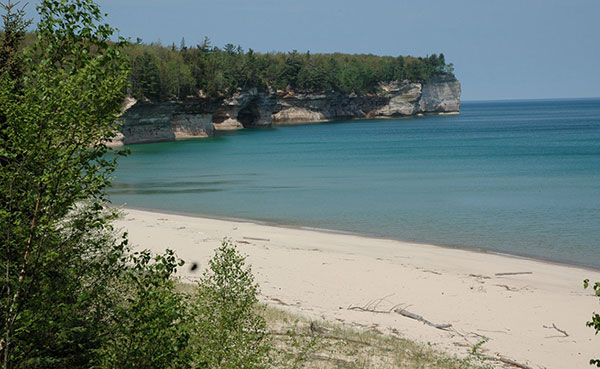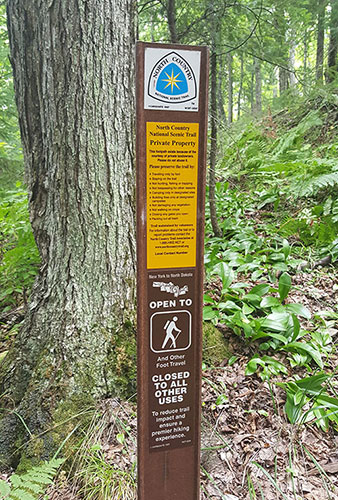National Park Service Sites in Michigan
- The National Park Service celebrates its 101st birthday today. Established on August 25th, 1916 by President Woodrow Wilson, the purpose of the NPS is to preserve America’s important natural and cultural sites, so that the public can enjoy and learn from them. Michigan has several locations overseen by the NPS, including some of our most popular and precious natural attractions.
Isle Royale National Park
Sitting 55 miles offshore from Michigan’s Upper Peninsula, in the cold, deep waters of Lake Superior, Isle Royale is the least visited National Park in the contiguous United States, because it is so remote. You can only access the island by boat or seaplane, and it’s closed completely from November to mid-April, due to the harsh winter conditions on the island.
If you’re looking for a true wilderness experience with little interruption from the outside world, you’ll find it at Isle Royale. The only hotel on the island, Rock Harbor Lodge, has 60 guest rooms and a dining room and grill. There are also two rustic cabins you can rent. Otherwise, you’ll need to bring your own overnight accommodation in the form of a tent. If you don’t plan on eating three meals a day at the lodge, you’ll also need to bring your own food or make due with the supplies available at the one small store on island.
Isle Royale’s wilderness is made up of rugged forests, streams, lakes and coves along the rocky Superior shoreline. You’re likely to also come across its largest inhabitant, moose, during your visit. Hiking, backpacking, kayaking, fishing and canoeing are the most popular pastimes on the island.
Pictured Rocks National Lakeshore

Chapel Beach is just one of the many beaches you’ll find in Pictured Rocks National Lakeshore. You can see the sandstone cliffs in the background. Photo courtesy of the NPS.
Pictured Rocks National Lakeshore is on Lake Superior’s south shore in Michigan’s Upper Peninsula. It’s one of our state’s most visited destinations in the summer.
The park’s name comes from the colorful sandstone cliffs that rise above the lake. They get their color from the minerals in the rock. Natural rock formations like arches and waterfalls abound in the area. Miner’s Castle is one famous formation, named because it looks like a castle turret.
Lush green forests with over 100 miles of hiking trails take you through the park. Miles and miles of pristine white-sand beaches are the perfect place for sunbathing and rock hunting.
Hiking, kayaking and waterfall hunting are prime activities, as well as visiting the area’s small towns like Munising and Grand Marais. You’ll also find lighthouses, maritime museums and Great Lakes shipwrecks you can tour.
Sleeping Bear Dunes National Lakeshore
Sleeping Bear Dunes National Lakeshore is along Lake Michigan’s northwest coast in the Lower Peninsula. This is another of our state’s most popular destinations for summer vacationers.
Miles and miles of sand dunes line the shore, towering as much as 400 feet above the lake. The Dune Climb is a popular activity, though it’s a long, steep climb all the way to the water. There are also plenty of beaches for swimming in Lake Michigan. If the water in the big lake is too cold, you can always visit one of the smaller inland lakes. You can also hike the many miles of forest trail or kayak the Platte and Crystal rivers.
The park is full of historical homes and other buildings that have been preserved, so you can see what life was once like along Lake Michigan is another era. You’re also close to the cherry orchards and vineyards the area is famous for.
Keweenaw National Historical Park

The Quincy Mine hoist is just one of the many things you see when you tour the old copper mine near Hancock, Michigan. The mine is part of the Keweenaw National Historical Park.
The Keweenaw National Historical Park is made up of 21 different locations throughout the Keweenaw Peninsula in Michigan’s Upper Peninsula. The park was created to preserve the area’s copper mining history and that of the immigrant populations who came there to work in the 1800s.
You can tour the Quincy Mine and Finnish American Heritage Center in Hancock, visit the historic towns of Calumet and Larium and go even farther afield to the Porcupine Mountains Wilderness State Park and Fort Wilkins State Park in Copper Harbor.
More locations and ideas for itineraries can be found on the park’s website.
Motor Cities National Heritage Area
The Motor Cities National Heritage Area is a collection of historic sites around the state that are integral to the automobile industry in Michigan. The Ford Piquette Avenue Plant in Detroit was the birthplace of the Model T. The Ypsilanti Automotive Heritage Museum features a variety of antique cars on display, including the Hudson Hornet. In Lansing, the R.E. Olds Transportation Museum tells the story of the Oldsmobile from its very beginning. The Henry Ford Museum celebrates the achievements of all of America’s great inventors, Ford included. Visit the Motor Cities National Heritage Area website for a complete list of all the sites.
North Country National Scenic Trail

The North Country Trail travels through some of Michigan’s most pristine wilderness.
The North Country Trail travels across seven states including Michigan. It begins in Pennsylvania and ends in North Dakota. The trail enters Michigan from Northwest Ohio and travels north through the Lower Peninsula passing Battle Creek, Middleville, Lowell and into the Manistee National Forest. You’ll then pass near Traverse City and Petoskey, eventually crossing the Straits of Mackinac into the Upper Peninsula. There you’ll head into the Hiawatha National Forest and continue west to Pictured Rocks, the Porcupine Mountains and finally Ironwood, where you’ll exit Michigan. Find complete information about the trail on the website.
River Raisin National Battlefield Park
This battlefield park preserves a brief, but interesting period in American history. It was the site of a War of 1812 battle between the U.S. and Tecumseh’s American Indian Confederation. The park’s visitor center houses artifacts from the battle. You can also take walking and driving tours of the battlefield and even tour it via kayak down the river. Special events throughout the year include re-enactments and demonstrations.
Father Marquette National Memorial
The Father Marquette National Memorial overlooks The Straits of Mackinac and tells the story of this 17th century French explorer and missionary who developed relationships with the Native Americans in Michigan’s northern wilderness. Marquette later went on to discover and map the Mississippi River with fellow explorer Louis Joliet. The memorial is located in Straits State Park near St. Ignace.



